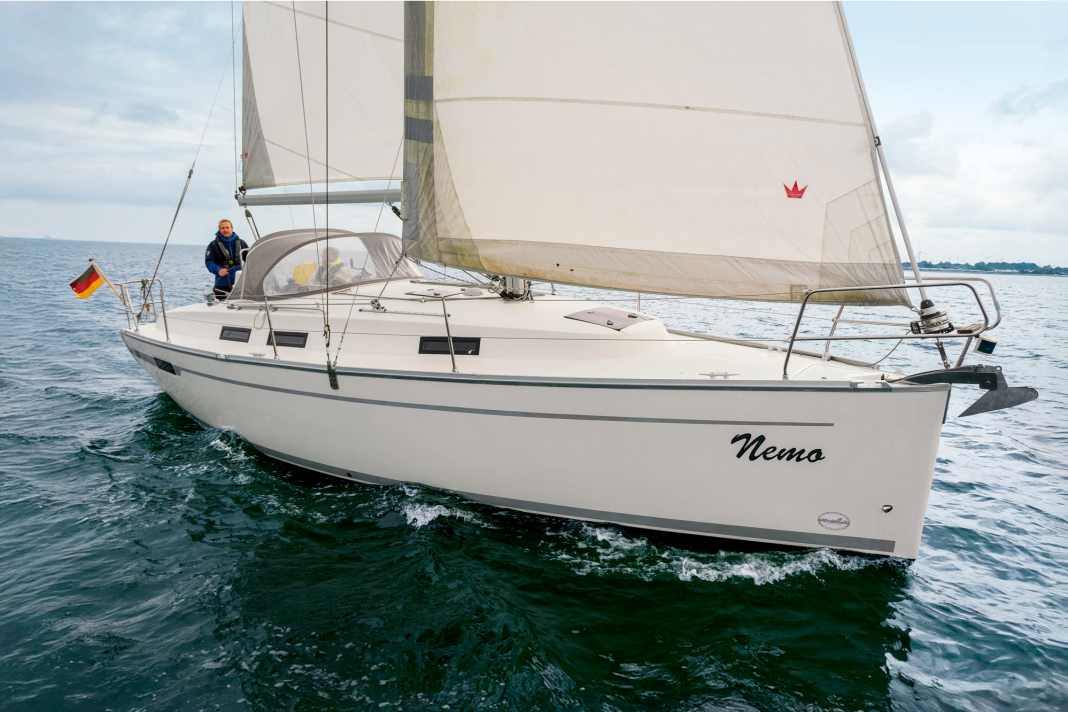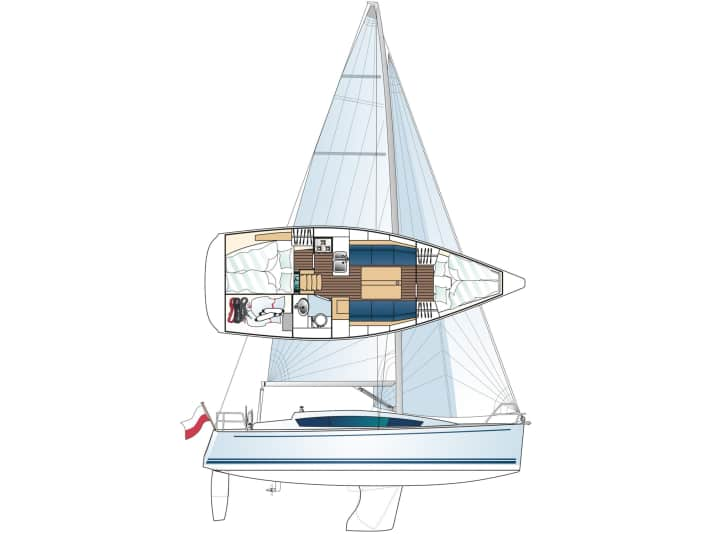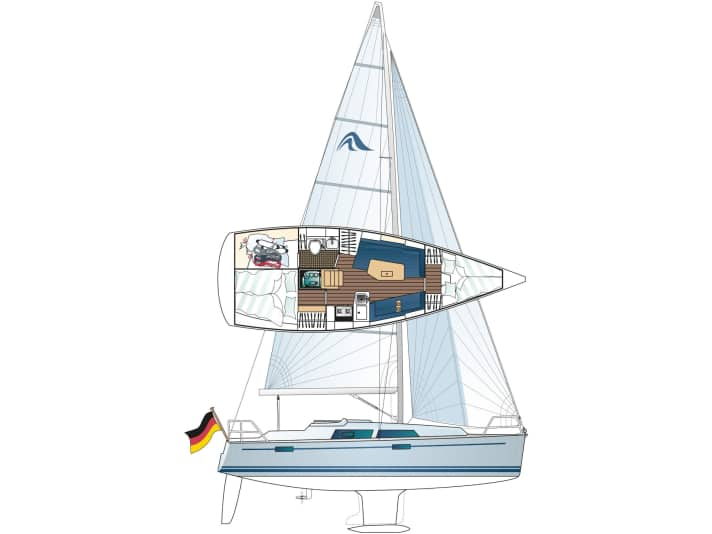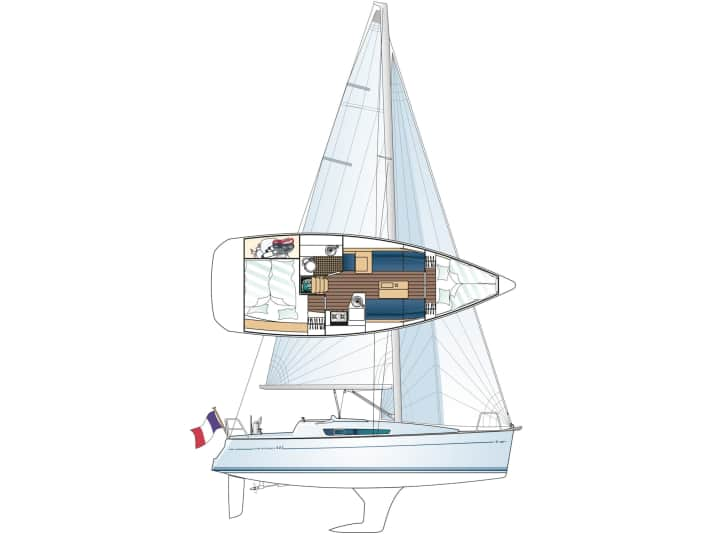





It could hardly be tougher: the test boat was a charter boat and belonged to the Mola fleet in Großenbrode. After 15 years of charter operation, the Bavaria is now for sale. A long time, which can have a deterrent effect on buyers, as the boat was used much more by changing crews than a conventional owner's boat. On the other hand, this test also offers a very good opportunity to pass judgement on the build quality. After all, it is easier for a little-used boat to cut a good figure in the test. This allows the boat to show what is possible even after years of heavy use.
More boats in the used boat test:
- Biga 24: Beautiful, fast and complete even as a used boat
- Bavaria 707: Trailerable small cruiser in a used boat test
- Hornet 32: High-quality cruising boat from the Elbe in a used boat test
- Moody Eclipse 33: The trailblazer in a used boat test
- Dufour 365 GL: Unconventional large series boat in a used boat test
The Bavaria Cruiser 32 was launched in 2009. To mark the new model series in the name, the designation "Cruiser" was moved in front of the length in feet. It was a break with the shipyard's traditions: the design by the American design studio Farr was more massive than the previous models. The embrasure-like superstructure windows in particular, created in collaboration with BMW Group Designworks, made an angular impression. However, the boat was convincing in the test at the time. The boat was characterised as "simple and fun" in the test report. The higher rig compared to the previous model was particularly emphasised here. The two-sailed mast has shrouds attached to the outside of the hull, which minimises the forces and ensures a good introduction into the hull. The cockpit controls were intuitive and the sailing performance was good. All this at an attractive price of less than 65,000 euros at the time.
Profile Bavaria Cruiser 32
- Design engineer: Farr Yacht Design
- Dimensions: 9.99 x 3.42 m
- Built: 2009-13
- Quantity: approx. 810
- New price 2009: 64.140 €
- Used price: approx. 69,500 €
These are also good prerequisites for buying a used boat. The 32 was already popular with sailors when it was launched, was sold 60 times in the first two weeks and is now regularly available as a used boat on the boat exchanges. The hull was also reused for the Cruiser 33 from 2012 and the Bavaria Cruiser 34 from 2016. The hull design was used in around 1900 boats. The cockpit layout and superstructure were redesigned in each case. Below deck and in terms of sailing characteristics, the two models are very similar. There are also variants of the 34 with two aft compartments. There is therefore a good selection with plenty of variety for interested used boat buyers.
We head out of the Großenbroder Binnensee for a test sail. The wind is blowing offshore at a light 8 to 10 knots. The sails are both furled. This is practical as the crew does not have to leave the cockpit. On the other hand, a mainsail also comes out completely without battens. The upwind wardrobe is visibly heavily used, which is not surprising for a used boat, especially one that has been moved around so much. Despite the somewhat out-of-shape profiles, the Cruiser 32 picks up speed quickly. Four knots upwind, five at 90 degrees. These figures are solid considering the sails. Especially as the sail load factor also characterises the 32 as a pure cruising boat. The value characterises the ratio of displacement to sail area and is 4.1 for the Bavaria 32.
Measured values of the Bavaria Cruiser 32



The shrouds attached to the outside also mean that a heavily overlapping genoa is not possible. This makes manoeuvres easy, as there is not much cloth to be tied in front of the mast. On deeper courses, the lack of sail area can also be compensated for with a gennaker. During the test run, the Bavaria proved to be an easy-to-operate boat that does exactly what the crew wants it to do. Very good! The layout is perfect for two people: One behind the wheel and the second in front. The mainsheet attached to the cockpit table can also be operated from the wheel.
The high coaming can also be used as a seat. Here, however, the arm has to be properly stretched towards the wheel. This is not ideal, but it does give you access to the genoa winches, wheel and mainsheet on your own. However, the step aft is not so quick, because the way over the dinghy is unavoidable. The 90 centimetre rudder leaves no gap to the dents. When sailing with a crew, you can make yourself comfortable behind the wheel on the upper edge of the bathing platform. This can be used as a seat in the upright position. The hatch was already included as standard and can therefore also be found on all used models. However, the mainsail with inmast furling is an extra.
The backstay is attached with a capstan and is simply trimmed using a tackle. Theoretically, the profile depth can be reduced by bending the mast a little more. The effect would certainly be even more pronounced with new sails. The rudder is set from hard to hard with a turn of the wheel. The very direct steering nevertheless provides sufficient feedback in the form of light pressure so that it can be steered quite sensitively.
Easy to handle under motor
Under engine power back into the harbour, the manoeuvring characteristics are very good. In the test boat, the engine operates at just under 30 hp, making it more powerful than the standard 18 hp jock. At 3,000 rpm, the hull, which measures just under ten metres, is pushed through the water at 7.3 knots. At cruising speed (2,400 rpm), the speed is still a very good 6.5 knots. With the powerful engine, the Bavaria also stops very quickly and turns in the tightest of spaces when accelerating with the rudder down, which is very advantageous for harbour manoeuvres where space is at a premium.
The boat also handles well when travelling in reverse. The 32 is therefore easy for two people to moor and unmoor. However, the width should not be underestimated. Here, 3.42 metres can be too much for smaller boxes. The freeboard of 1.15 metres can also make it difficult to moor from a low floating dock. However, this problem can be easily solved by mooring backwards and lowering the bathing platform.
Good support, but little storage space
The voluminous dimensions are favourably noticeable below deck. There is a classic layout with a navigation table to port and an L-shaped galley to starboard. The door to the foredeck is slightly off-centre to port, creating a better passageway past the saloon table and the bench to starboard forms a cosy corner here.
The light-coloured plastic surfaces enhance the feeling of space. It feels cosy below deck, even though the superstructure windows are extremely flat. However, it must be emphasised positively that they can all be opened, allowing cross ventilation.
The saloon benches can also be used as berths. The length of just under two metres makes it possible, and with a width of over 60 centimetres it is tight, but still feasible. There is also a bunk in the foredeck, which is also comfortable for two people. There is also plenty of space for two adults in the aft cabin, with the only restriction being that the cockpit on one half limits the space above.
The wet room offers plenty of space on the port side. The grating above the shower sump was missing on the test boat. The galley makes a good impression. The all-round stainless steel rail is nice and provides a good grip at sea. However, the storage space is a little tight. It's enough for pots and plates, but there's no room for fresh food except in the fridge. They have to find a corner under the saloon bench. However, most of the space on the port side is already taken up by batteries. If all six possible berths are occupied, the crew will definitely have to be sparing with their luggage. A large number of handles both on the companionway and near the navigation system and in the wet room should be emphasised. The shelves in the saloon are also so solidly made that you can hold on to them without hesitation.
On deck, there is plenty of storage space in the port side locker: it measures 1.45 x 0.94 x 1.01 metres. The cockpit table is also particularly spacious for this size of boat.
Wear and condition of the used boat
The assessment of the condition of the Bavaria Cruiser 32 is particularly exciting. The gelcoat on the deck and hull still look good. Only the teak coating in the cockpit and on the bathing platform needs to be treated with at least a fungicide or even sanded down. The window frames on the superstructure need a new coating; on the test boat they are peeling off a little. The running rigging and the sheets are already relatively stiff, and new material will increase comfort during manoeuvres and trimming. However, this is not unusual for a used boat. The interior fittings are a positive surprise. There are visible signs of wear and tear in the companionway and galley area. However, this is to be expected after 15 years of charter. However, the damage is superficial in the paintwork. In addition, all edges and mouldings are very solid. This means that some sanding can be carried out on particularly stressed areas without any problems.
There is no operating hours counter on the engine. It can be assumed that there are a lot of them. It gives the impression that there may be a leak in the exhaust manifold. Future owners should definitely clarify this. However, if everything else is in order with the machine, the repairs will remain within manageable limits.
Which brings us to the surprising price: 69,500 euros! That's more than 5,000 above the original price. For a 15-year-old boat. However, other offers confirm the impression that this is not a single outlier upwards. Used yachts are very much in demand at the moment. At Mola, we are told that this is also due to the extreme rise in new boat prices. Many customers here are opting for a used yacht, which is increasing demand and therefore also prices. The Bavaria Cruiser 32 has therefore achieved something that was previously reserved for the more popular Hallberg-Rassy models: very good value retention and even an increase in value over the years.
YACHT review of the Bavaria Cruiser 32
Praised in 2009 as a "rock-solid tourer with a new design approach", the Cruiser 32 can now also impress as a used boat.
Design and concept
Good room layout
Bathing platform as standard
Small built-up windows
Sailing performance and trim
High stability in the wind
Simple operation
Successful cockpit layout
Living and finishing quality
Spacious aft chamber
Six berths
Little storage space in the pantry
Equipment and technology
Very good deck layout
Cockpit shower
/(+)Roll large is practical, but does not stand so well
The Bavaria Cruiser 32 in detail

Technical data of the Bavaria Cruiser 32
- Design engineer: Farr Yacht Design
- CE design category: A
- Torso length: 9,75 m
- Total length: 9,99 m
- Waterline length: 8,85 m
- Width: 3,42 m
- Draught/alternative: 1,95/1,50 m
- Mast height above WL: 14,80 m
- Theor. torso speed: 7.2 kn
- Weight: 5,2 t
- Ballast/proportion: 1,3 t/25 %
- Mainsail: 28,3 m²
- Furling genoa (109 %): 22,3 m²
- machine (Volvo P.): 19 kW/27 hp
- Fuel tank: 150 l
- Fresh water tanks (2): 150 l
- Holding tank: 50 l
Model history and design
GRP sandwich (foam core 16 mm) in hand lay-up. Full laminate below the waterline. Isophthalic acid resins for the outer layers. The hull design was reused for the Cruiser 32, 33 (2012) and 34 (2016). The deck and cockpit were further developed. This means that large numbers are available, but also different variants as used boats. The Cruiser 34 with the Farr hull can still be ordered and is the smallest Bavaria (read the detailed test here).
Market situation
Due to the high number of units over the years and the model history, there are often several 32s on offer on the used boat portals.
You must pay attention to this during the viewing
There are no particular weak points. In general, the teak covering in the cockpit is usually in need of refurbishment. Wear is to be expected when the boat is under sail. Hairline cracks can occur under the railing supports.
The competition of the Cruiser 32 on the used boat market
Delphia 31

The focus of the Delphia is clearly on living space, but the sailing characteristics are not neglected.
Hanse 320

Visually appealing cruiser with great performance under sail. Easy handling thanks to the self-tacking jib.
Oceanis 31

A solid cruising boat with an uncomplicated and well-rounded overall concept. The Oceanis 31 is particularly cosy.
Sun Odyssey 33i

Imaginative boat with many good details. Sporty sailing characteristics with performance package.
ADVERTISEMENT

Insure your Bavaria 32 from 552.72 euros per year* - liability and comprehensive cover. Many options possible: Fixed rate and partial damage without deductions "New for old" possible. Simply calculate online and take out insurance: yachting24.de
* Yachting24 offer valid for a sum insured of 54,500 euros (with current value cover), excess: 1,100 euros, liability cover: 8 million euros.

